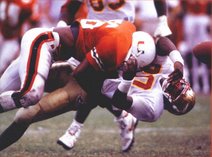| (Photo Credit: ViewFromMySeat.com) |
Written By: Nathan Skinner
Canes Rising Contributor
The University of Miami is a unique institution. It's a small, private institution with a miniscule donor base, a lack of dedicated fans, and an alumni base that is more widespread than most of its peers. Those are the reasons why Miami tends to struggle in the attendance category. Some have suggested that a stadium closer to campus would correct that, even though the financials and the logistics suggest otherwise. It's time to look at what is truly hurting the program. Spoiler Alert: It's not the stadium.
Madison Cramer of Inside The U wrote an article on the subject, using an informal poll of current undergraduate students to bolster her point. While Ms. Cramer may be a very nice person, and a talented writer, she obviously hasn't taken a statistics course. An informal poll of .62% of the undergraduate student body doesn't really illustrate anything, besides that the people in the poll are unhappy. The typical undergrad may want an on campus stadium, but there's a case study that shows that even with a on campus facility, students will find a way to avoid attending events. That case study is the men's basketball program, and the history of student involvement at the BankUnited Center. It's been spotty for most of the last decade, with major spikes for major games, and historic seasons. Other than that, it's been an uphill struggle to get students to games. The same students that complain about being unable to fill a 70,000 seat stadium struggle to consistently fill a 2,000 seat student section in the BUC. That's with an on-campus arena, an arena with ample parking that is within walking distance for every on-campus resident. Students don't have to deal with oppressive heat, torrential downpours, or a drunken classmate vomiting on their shoes at the BUC. Yet, unless the 'Canes are playing a top 15 team, or are on the verge of something historic, students aren't anywhere near the arena. Therefore, it's safe to say it's not the distance keeping students away from basketball, for more students show up to football games than basketball. It's not the stadium that is keeping students away, it's the on field product. The product isn't compelling, and it's not consistent.
Ms. Cramer mentioned the proposed MLS stadium as a potential home for the 'Canes, and while there's some positives to the proposed stadium, it's a net negative overall. I wrote an article about the proposed stadium, which covered those net negatives. Miami isn't winning because recruits are seeing an empty stadium, recruits have seen somewhat empty stadiums for most of the last 30 years. Even during the glory years, Miami struggled to attract fans, and recruits know that. What Miami has to offer recruits is unique, and it goes beyond a packed stadium. Miami offers a chance to play in an NFL atmosphere, while still getting to experience college life. That's what makes Miami attractive to recruits, provided the on field product is compelling. Where the University is falling behind is on campus facilities, and paying coaches. That's where The U lags behind the competition, and the areas in which Miami has to improve, if they are to compete with the other football powers.
Over the last decade, coaching salaries have exploded. In 1999, Bobby Bowden was one of few coaches making 2 million dollars per season. That's no longer the case, as 50 of the 126 head coaches in the Football Bowl Subdivision(FBS) make over 2 million dollars per season. Al Golden is the 46th highest paid coach in the country, making just over 2 million dollars per season. Miami has to find a way to at least be in the ballpark in regards to coaching salaries. Al Golden is making 2 million, if he starts winning titles, that should be bumped up to 3.5-4 million per year. If Golden is dismissed, the search committee should be willing to spend upwards of 4 million per season to attract a coach who can succeed. This attitude should also be applied to assistants. Miami may not be able to pay two million dollars for an offensive coordinator, but $750,000 should be enough to find someone who can succeed with the talent The U attracts.
It's not only coaching salaries that have exploded. The size of training facilities have exploded over the last decade as well. When schools like Rutgers and Oregon decided to upgrade their aging facilities, it set off an arms race, with everyone getting involved. Schools like Alabama, Auburn, and Florida now have training facilities that are better than most NFL teams, with items like luxury buffet lines, and lockers with flat screen TVs. Miami has attempted to upgrade with the recent addition of the Schwartz Center, but that facility is already behind the curve. This is the conundrum that Miami finds itself in: Miami has to keep pace with institutions that have a significant head start, and will always be able to match and surpass The U.
To meet this challenge, Miami has gotten proactive in the fundraising game, establishing the Building Champions campaign. This fundraising campaign has raised the funds needed to update the practice field, and install a much needed student-athlete dining facility. While Miami may never have the palatial facilities of UF or 'Bama, these facilities are outstanding enough to draw recruits, provided Miami is anywhere near compelling on the field. The key is to find new revenue streams, the most important of which may lay in the corporate sector. While Miami can't match the donor base of UF, there's major corporations here who are always looking for a naming opportunity, and it's time for The U to take advantage. That's the only way Miami can stay relevant.



